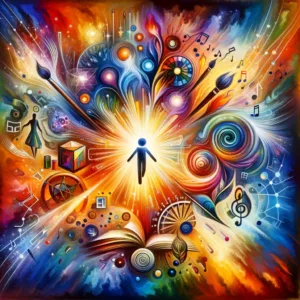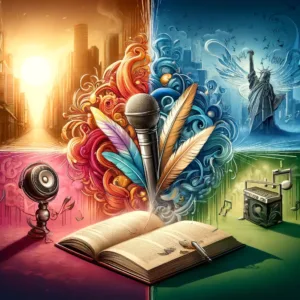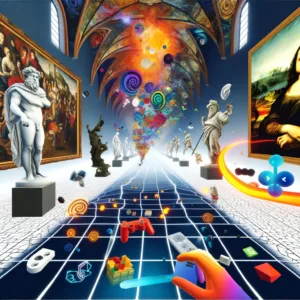Art, in its myriad forms, has always been a powerful vector of human expression. Throughout history, it has served as a mirror to societies, reflecting their beliefs, hopes, and struggles. But beyond its role as a witness to history, art holds a profound and personal influence, particularly significant during adolescence—a period of transformation and self-discovery.
At this pivotal age, where the quest for identity becomes paramount, art offers a judgment-free space for experimentation and personal expression. It becomes a means to explore one’s deepest thoughts and emotions, often challenging to verbalize. This capacity of art to serve as an outlet is all the more essential for adolescents, allowing them to navigate through the emotional and social turbulence of this phase of life.
From Art to Self-Confidence
But art does not merely provide a voice for unexpressed thoughts and emotions; it is also a powerful vector of self-confidence. Each artistic creation, whether it’s a drawing, a piece of music, a text, or a performance, is a self-affirmation, a stance taken in the world. For an adolescent, having their work recognized and appreciated by others can be a tremendous boost to self-esteem.
Art, in its diversity, welcomes all forms of expression, allowing adolescents to find the medium that resonates most deeply with their inner being. Whether through painting, sculpture, music, theater, dance, or writing, young artists can explore and express their ideas, feelings, and worldview.
This artistic exploration and expression acknowledge and celebrate the uniqueness of each individual, affirming that every perspective, no matter how personal, has value.
By creating something personal and meaningful, young artists become aware of their ability to influence the world around them. Each completed artistic project is an achievement that bolsters self-confidence. This sense of accomplishment is amplified when they share their work with others, receiving positive and constructive feedback in return. Even criticism can be empowering, as it is an integral part of the creative process, teaching perseverance and resilience.
These activities allow them not only to understand and express who they are but also to recognize the value of their individual contribution to the world. This recognition and self-affirmation are essential for building solid self-esteem, conducive to lasting personal fulfillment.
 From Art to Open-mindedness
From Art to Open-mindedness
Moreover, engagement in artistic activities fosters open-mindedness. Art, by its very nature, invites curiosity, the exploration of different cultures, ideas, and techniques. For adolescents, this represents a unique opportunity to step out of their comfort zone, discover the world from different angles, and develop an appreciation for the diversity of human expression. This open-mindedness, acquired through art, is a valuable skill in our increasingly globalized and interconnected world.
Richness and diversity
Art, with its richness and diversity, acts as an open window to the world, offering young people the opportunity to explore and understand a variety of cultures and perspectives. By engaging with works from different cultural and historical contexts, adolescents can significantly broaden their understanding of the world, thus developing an essential open-mindedness in our interconnected global society.
Engaging with art from a global perspective not only encourages aesthetic appreciation but also cultivates empathy and intercultural understanding. By learning to appreciate arts and cultures previously foreign to them, young people develop an open-mindedness that transcends biases and stereotypes. This ability to embrace and celebrate diversity is invaluable, preparing young individuals to navigate and contribute positively to an increasingly cosmopolitan world.
Exploration and Sharing of Feelings
Art has a unique ability to capture and communicate the essence of human experiences, making it a powerful vehicle for awakening and sharing empathy. By engaging in artistic activities, children and adolescents learn not only to express their own emotions constructively but also to connect with the feelings and experiences of others. This dual capacity for expression and reception profoundly strengthens empathetic skills.
Artistic activities provide a safe space where young people can explore and express complex or difficult-to-verbalize feelings. Whether through painting, music, dance, theater, or writing, art allows for the materialization of emotions, thoughts, and personal experiences. This self-expression helps to lighten emotional burdens and contributes to better mental health.
Sharing and understanding
Furthermore, by sharing their creations with others, whether in a family, school, or community setting, young artists open themselves up to the possibility of being understood and connected with others. This sharing promotes deep emotional communication, allowing individuals to feel seen and heard in their unique experiences.
Exposure to artworks created by others also plays a crucial role in developing empathy. By encountering perspectives and stories different from their own, young people learn to put themselves in others’ shoes, to feel what they feel, and to understand the context of their lives. This ability to identify and sympathize with others is at the heart of empathy.
In summary, art acts as an emotional bridge between individuals, enabling not only deep personal expression but also meaningful connections with others. By fostering these interactions through artistic expression, we can cultivate a generation of deeply empathetic young people, capable of understanding and valuing the shared experiences and emotions that unite us as human beings.
From Street Art to Literature, from Rap to Poetry
Art, in its purest essence, is an expression of humanity—a manifestation of our emotions, ideas, and experiences. This expression knows no boundaries and is not confined to galleries, theaters, or concert halls. Art is everywhere around us, in the most unexpected spaces and in incredibly diverse forms. There is no such thing as “illegitimate” art; every form of artistic expression holds its own value and significance, reflecting the richness and diversity of human experience.
Street Art
For example, street art transforms urban spaces into living canvases, telling stories of resistance, beauty, injustice, and hope to those who venture into the streets. These often ephemeral works capture the essence of a community’s soul, reflecting its struggles and dreams.
Rap
Rap, on the other hand, is a powerful form of rhythmic poetry, giving a voice to the voiceless. It articulates the lived experiences of often marginalized communities, addressing themes such as social injustice, poverty, and the aspiration for a better future. Rap is a deeply personal means of expression and, at the same time, a collective cry that resonates far beyond its musical roots.
Creating content
Creating content on platforms like YouTube has also opened new avenues for artistic expression. Videographers not only share their creativity but also their knowledge, passions, and lives, reaching global audiences and creating tight-knit communities around diverse content.
Express yourself and discover
The important thing is not the medium chosen but the fundamental need to express and share a part of oneself with the world. Each person finds their own way to do this, whether through music, painting, dance, writing, or any other form of art. These modes of expression are universal languages, transcending linguistic, cultural, and social barriers.
By recognizing and celebrating the diversity of artistic forms, we acknowledge the intrinsic value of each individual and their unique contribution to the collective tapestry of human experience. Art, in all its forms, enriches our lives, unites us in our diversity, and encourages us to see the world in a new light. Fostering this free and open expression is essential for a vibrant, empathetic, and connected society.
 Video Games: A New Art Form?
Video Games: A New Art Form?
Video games, often viewed through the prism of their playful aspect, are in fact a distinct form of art, competing with traditional arts in terms of creative complexity and cultural impact. Like cinema, recognized as the seventh art, video games deserve a prime spot in the contemporary artistic landscape.
Each video game is a symphony of artistic elements meticulously orchestrated: soundtracks developed specifically to accompany and enrich the gaming experience, visual aesthetics ranging from hyper-realism to the abstract, deep narratives exploring varied and complex themes, as well as gameplay mechanisms that engage the player in these creative universes interactively.
An immersive experience
The art of video games transcends mere distraction to become an immersive experience that engages the intellect, awakens emotions, and stimulates the imagination. Like in cinema, literature, or music, video games tell stories, express ideas, and provoke thought, but with a unique distinction: they offer the audience not the role of a spectator, but that of an active participant in the artwork. This interactivity opens new avenues for artistic expression and emotional connection.
Therefore, there is no form of art more “legitimate” than another. The hierarchy of art forms is an outdated concept that fails to account for the richness and diversity of human expression. Whether through painting, sculpture, music, cinema, or video games, each form of art possesses its own value, language, and ability to deeply and meaningfully touch people. By recognizing video games as a distinct art form, we broaden our appreciation of human creativity and celebrate all the ways art can enrich our experience of the world.
A gateway to curiosity
Many video games serve as an initial gateway to discovery, offering narratives deeply inspired by significant historical events, literary works, or artistic achievements. Through the immersive and interactive nature of video games, players are not just passive recipients but active participants in stories that weave through the annals of history, the depths of classic literature, or the intricacies of art. This engagement provides a unique educational experience, where learning becomes an adventure, sparking curiosity and a desire to explore the real-world origins of the stories encountered in-game. By traversing these digital landscapes, players often find themselves on a path to further research and appreciation of the historical, literary, and artistic references embedded within their favorite games, making video games a powerful tool for cultural education and a bridge to the wider world of knowledge.
Assassin’s Creed as a Gateway to History:
Other Gateways Through Video Games:
Bringing Art into Your Family’s Life
In a bid for inclusion and democratization of access to culture, numerous cities and museums are launching initiatives to make art and culture accessible to everyone. These accessibility moments come in various forms, such as open house days, reduced rates, or even free access for certain demographics, and special programs designed for families, schools, and groups from less privileged backgrounds.
Concurrently, socio-cultural centers play a crucial role within neighborhoods, providing a space for meeting and exchange around artistic and cultural activities. These centers become places where art is experienced and shared, thus fostering the emergence of engaged and creative communities.
Cultural associations, often driven by a passion for art and a desire to share, also contribute to this mission of accessibility by organizing workshops, exhibitions, and performances in unconventional spaces, thereby making culture tangible and alive at the heart of communities. Furthermore, parental involvement in the cultural life of schools offers another valuable pathway to access art.
By collaborating with educational institutions to implement artistic and cultural activities, parents actively participate in their children’s cultural education, opening the door to enriching experiences that nurture curiosity and personal growth.
These combined efforts of cities, museums, socio-cultural centers, associations, and families illustrate a common will to break down barriers to cultural access, affirming that art and culture are fundamental rights essential to the enrichment of social and individual life.
Some Tips
Legitimizing a child or teenager’s passions means recognizing and valuing their interests as legitimate paths for exploration and self-expression. If a young person is passionate about makeup, discussing the creative use of makeup in cinema and series together can enrich their understanding and appreciation of this art. For a video game enthusiast, exploring together the narratives and worlds they offer can lead to enriching discussions about storytelling and culture. Share musical discoveries between parents and children, or explore together the universe of series and movies. Discover together the street art in your area.
Take advantage of digital resources to explore art together. Virtual museum tours, online art tutorials, and creative applications can offer artistic experiences accessible from the comfort of your home.
Some Useful Resources
Shazam Art with Magnus
Discover:
Conclusion
By embracing the diversity of artistic forms and acknowledging the legitimacy of each passion, we open the door to a wealth of educational and emotional experiences for children and adolescents. Whether through traditional art or modern mediums such as video games, makeup, music, or series and movies, it is crucial to support and value the individual interests of the young.
As parents and educators, actively encouraging these explorations fosters rich and diversified personal growth and builds an invaluable bridge of dialogue and sharing. Ultimately, legitimizing and sharing the passions of children and adolescents teaches them that all forms of expression have value, thereby enriching their life journey with an open-mindedness and deep empathy for the world around them.
Mr. Arthur, by balancing screen time between entertainment and learning, fosters this curiosity and attraction towards art. There are educational applications designed to introduce and deepen knowledge in various artistic fields. We consider these tools as crucial for a comprehensive education. Moreover, the learnings we highlight can guide children and teenagers in discovering their passions. This approach not only enriches their understanding of the world but also cultivates an environment where curiosity is valued, and the pursuit of personal interests is encouraged, laying the groundwork for lifelong learning and passion exploration.
 From Art to Open-mindedness
From Art to Open-mindedness
 Video Games: A New Art Form?
Video Games: A New Art Form?